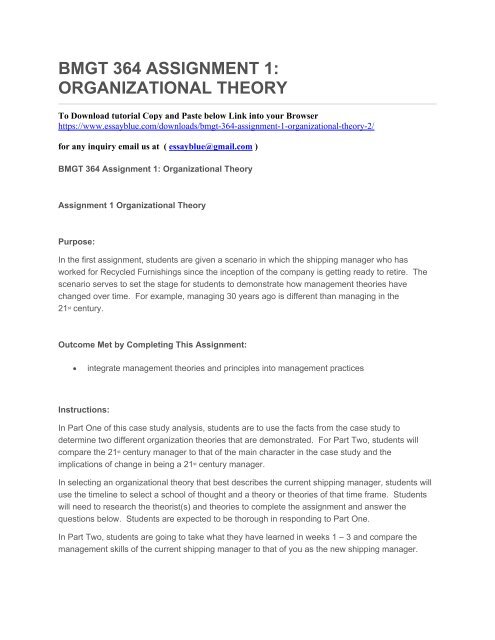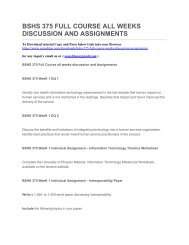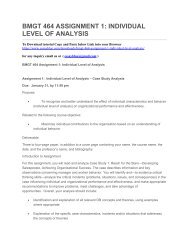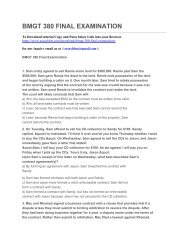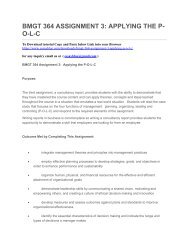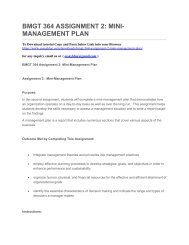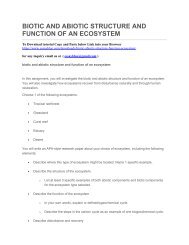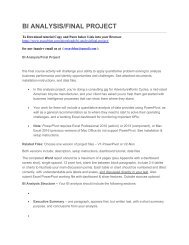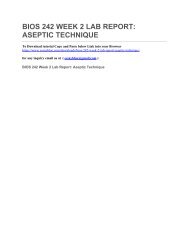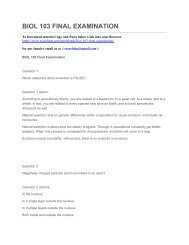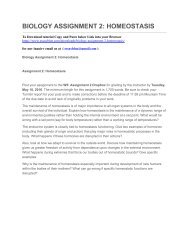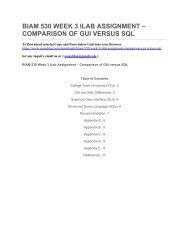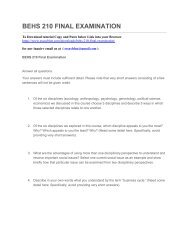BMGT 364 ASSIGNMENT 1 ORGANIZATIONAL THEORY
You also want an ePaper? Increase the reach of your titles
YUMPU automatically turns print PDFs into web optimized ePapers that Google loves.
<strong>BMGT</strong> <strong>364</strong> <strong>ASSIGNMENT</strong> 1:<br />
<strong>ORGANIZATIONAL</strong> <strong>THEORY</strong><br />
To Download tutorial Copy and Paste below Link into your Browser<br />
https://www.essayblue.com/downloads/bmgt-<strong>364</strong>-assignment-1-organizational-theory-2/<br />
for any inquiry email us at ( essayblue@gmail.com )<br />
<strong>BMGT</strong> <strong>364</strong> Assignment 1: Organizational Theory<br />
Assignment 1 Organizational Theory<br />
Purpose:<br />
In the first assignment, students are given a scenario in which the shipping manager who has<br />
worked for Recycled Furnishings since the inception of the company is getting ready to retire. The<br />
scenario serves to set the stage for students to demonstrate how management theories have<br />
changed over time. For example, managing 30 years ago is different than managing in the<br />
21 st century.<br />
Outcome Met by Completing This Assignment:<br />
<br />
integrate management theories and principles into management practices<br />
Instructions:<br />
In Part One of this case study analysis, students are to use the facts from the case study to<br />
determine two different organization theories that are demonstrated. For Part Two, students will<br />
compare the 21 st century manager to that of the main character in the case study and the<br />
implications of change in being a 21 st century manager.<br />
In selecting an organizational theory that best describes the current shipping manager, students will<br />
use the timeline to select a school of thought and a theory or theories of that time frame. Students<br />
will need to research the theorist(s) and theories to complete the assignment and answer the<br />
questions below. Students are expected to be thorough in responding to Part One.<br />
In Part Two, students are going to take what they have learned in weeks 1 – 3 and compare the<br />
management skills of the current shipping manager to that of you as the new shipping manager.
Step 1: Analyze the Case Study (Read: How to Analyze a Case Study)<br />
Step 2: Create a Word or Rich Text Format (RTF) document that is double-spaced, 12-point font.<br />
The final product will be between 4-5 pages in length excluding the title page and reference page.<br />
Step 3: Review the grading rubric for the assignment.<br />
Step 4: Use headings following this format:<br />
<br />
<br />
<br />
<br />
Title page with title, your name, the course, the instructor’s name;<br />
Introduction (one paragraph that briefly describes the situation and tells a reader the main<br />
points of the paper;<br />
Part One;<br />
Part Two.<br />
Step 5: In writing a case study, the writing is in the third person. What this means is that there are<br />
no words such as “I, me, my, we, or us” (first person writing), nor is there use of “you or your”<br />
(second person writing). If uncertain how to write in the third person, view this<br />
link: http://www.quickanddirtytips.com/education/grammar/first-second-and-third-person<br />
Step 6: In writing this assignment, students are expected to support the reasoning using in-text<br />
citations and a reference list. If any material is used from a source, it must be cited and referenced.<br />
A reference within a reference list cannot exist without an associated in-text citation and vice versa.<br />
View the sample APA paper under Week 1 content.<br />
Step 7: In writing this assignment, students are expected to paraphrase and not use direct quotes.<br />
Learn to paraphrase by reviewing this<br />
link: https://writing.wisc.edu/Handbook/QPA_paraphrase2.html<br />
Step 8: In writing this assignment, students may use external resources but the majority of<br />
resources will come from the course.
Step 9: Read critically and analyze the following scenario:<br />
Part One<br />
Scenario:<br />
Recycled Furnishings is a division of an international home furnishing company called Thor<br />
Enterprises. Recycled Furnishings makes glass sofas for outdoor use from recycled bottles and<br />
glass. The business has grown rapidly in the last thirty years and now that it has become a division<br />
of Thor Enterprises, the company is going international. The shipping manager for Recycled<br />
Furnishings, Robert, has been in his job since the start of the company. Prior to coming to Recycled<br />
Furnishings, Robert worked as a container manufacturing engineer at Damco, a local shipping<br />
company and worked his way up to supervisor prior to joining Recycled Furnishings. Robert, a baby<br />
boomer, quickly rose to supervisor at Damco because of his ability to optimize the way tasks were<br />
performed and his knack to implement processes so workers could be trained to perform their<br />
specialized sequence of motion in one best way. He brought this management style to Recycled<br />
Furnishing and helped to improve the methodology of furniture assembly as well as the shipping<br />
processes.<br />
A major shift in management occurred in the late 1980’s and early 90’s that caused Robert to<br />
reconsider his management approach. For example, advances in technology, the organization<br />
joining a union, change in the value systems, organizational design and globalization all affected the<br />
culture of Recycled Furnishings. Robert was successful with this transformation and contributed<br />
greatly to the company’s success.<br />
In answering the following questions, make sure that the facts of the scenario and the course<br />
readings support the reasoning of the answers provided.<br />
<br />
<br />
<br />
<br />
<br />
Discuss the school of thought that best describes Robert’s management style when he first<br />
joined Recycled Furnishings.<br />
Discuss the theorist under the identified school of thought that best depicts Robert’s<br />
management style. What contribution did this theorist make to management and why was his<br />
or her contribution important to the field of management?<br />
Select and discuss the school of thought that best describes the management style Robert<br />
used once the shift took place? Why is this school of thought the best choice?<br />
Select and discuss one theorist who supports this school of thought. Address the principles<br />
of the theory and how a manager would do his job and interact with his staff. How does what<br />
the theorist proposed support the facts in the case study?<br />
Compare and contrast the current management thought with Robert’s early thinking;
Part Two<br />
Scenario:<br />
Recently Robert announced his plans to retire. You have been hired as his replacement and with<br />
the international launch on the horizon you have big shoes to fill. You feel you are more than<br />
capable of handling the shipping manager position and characterize yourself as a 21 st century<br />
manager.<br />
<br />
<br />
<br />
As a 21 st century manager, compare the way you will manage versus the way of Robert;<br />
What implications do the changes in management have for the future of Thor?<br />
How will the new approach to the job likely change the shipping division?<br />
Step 10: Create the introductory paragraph. Within this paragraph, provide a brief overview of the<br />
scenario. Then, provide a thesis statement and tell the reader the main topics covered in the paper.<br />
The introductory paragraph is the first paragraph of the paper but is typically written after writing the<br />
body of the paper (Questions students responded to above). View this website to learn how to write<br />
an introductory paragraph: http://www.writing.ucsb.edu/faculty/donelan/intro.html<br />
Step 11: Respond to the questions in Part One and Part Two following the format provided. Be<br />
clear and concise in the writing and make sure the questions are comprehensively answered.<br />
Step 12: Using the grading rubric as a comparison, read through the paper to ensure all required<br />
elements are presented.<br />
Step 13: Proofread the paper for spelling and grammatical issues, and third person writing.<br />
<br />
<br />
<br />
Use the spell and grammar check in Word as a first measure;<br />
Have someone who has excellent English skills to proof the paper;<br />
Consider submitting the paper to the Effective Writing Center (EWC). The EWC will provide<br />
4-6 areas that may need improvement.<br />
Step 14: Submit the paper in the Assignment Folder.


